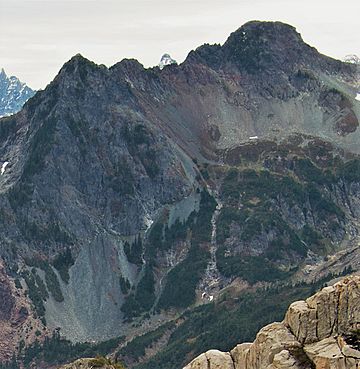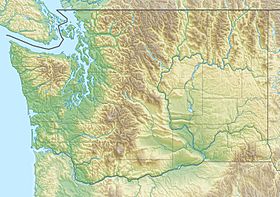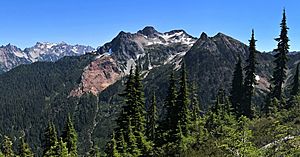Silvertip Peak facts for kids
Quick facts for kids Silvertip Peak |
|
|---|---|

Silvertip Peak, west aspect
|
|
| Highest point | |
| Elevation | 6,140 ft (1,870 m) |
| Prominence | 1,300 ft (400 m) |
| Isolation | 2.30 mi (3.70 km) |
| Parent peak | Gothic Peak (6,213-ft) |
| Geography | |
| Location | Snohomish County, Washington, U.S. |
| Parent range | Cascade Range |
| Topo map | USGS Monte Cristo |
| Climbing | |
| Easiest route | class 3-4 scrambling south ridge |
Silvertip Peak is a mountain in Washington state. It stands 6,140 feet (1,871 meters) tall. You can find it in the beautiful North Cascades mountain range. This peak is located in Snohomish County.
Silvertip Peak is about 3.5 miles south of Barlow Pass. It's along the scenic Mountain Loop Highway. The mountain is part of the Henry M. Jackson Wilderness. This land is managed by the Mount Baker-Snoqualmie National Forest. Water from the mountain flows into the Sauk River to the north. To the south, it drains into Silver Creek, which joins the Skykomish River.
Many other peaks are close to Silvertip Peak. These include Gothic Peak, Del Campo Peak, Sheep Mountain, Cadet Peak, and Columbia Peak. Silver Lake and Poodle Dog Pass are on the east side of Silvertip. The old mining ghost town of Monte Cristo is at its northeast base. Another ghost town, Mineral City, is at the southern foot of the peak. Silvertip Peak got its name from a nearby mining claim called Silver Tip.
Mountain Weather
Silvertip Peak is in a "marine west coast" climate zone. This means it gets a lot of rain and snow. Most of the weather comes from the Pacific Ocean. It travels northeast towards the Cascade Mountains.
When weather fronts hit the North Cascades, the mountains force the air upward. This makes the air cool down and drop its moisture. This process is called Orographic lift. It causes a lot of rain or snow on the west side of the North Cascades.
During winter, there is heavy snowfall. The snow tends to be wet and heavy. This can lead to a high risk of avalanches. Because of the ocean's influence, temperatures rarely go below 0°F (-18°C) or above 80°F (27°C).
Winters are usually cloudy. But in summer, high pressure systems over the Pacific Ocean bring clear skies. The best time to visit or climb Silvertip Peak is from July to September.
How the Mountains Formed
The North Cascades have very rugged land. You can see sharp peaks, long ridges, and deep valleys carved by glaciers. These amazing shapes were created by geological events over millions of years. These events also caused big changes in elevation. This led to different climates and types of plants in the area.
The Cascade Mountains started forming millions of years ago. This was during the late Eocene Epoch. At that time, the North American Plate was slowly moving over the Pacific Plate. This caused many volcanic eruptions. Also, small pieces of the Earth's crust, called terranes, joined together. This helped create the North Cascades about 50 million years ago.
Over two million years ago, during the Pleistocene period, glaciers moved across the land many times. They scraped and shaped the landscape. They left behind piles of rock and debris. The river valleys in the area have a "U" shape. This shape was created by these recent glaciers.
The tall peaks and deep valleys of the North Cascades were formed by a combination of things. These include the land being pushed upward (orogeny), cracks in the Earth's crust (faulting), and the powerful action of glaciers.




